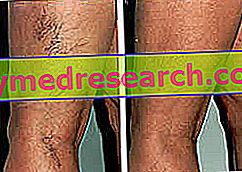Generality
Actinic cheilitis (also called solar cheilitis ) is a form of actinic keratosis localized to the lips .

This pathology is related to sun exposure and, in detail, results from the cumulative effect of ultraviolet radiation .
In most cases, actinic cheilitis manifests itself with loss of demarcation between the lip and the surrounding skin, thickening, erythema and annoying and painful cracks.
The treatment involves the use of drugs and the removal of the lesion by classical surgery or diathermocoagulation.
What's this
What is Actinic Cheilitis (or Solar Cheilitis)?
Actinic cheilitis is a condition caused by damage to the labial epithelium, secondary to chronic exposure to the sun .
Key points
- " CHEILITE " is the medical term that indicates the presence of an inflammation of the lips .
- Solar cheilitis is considered a clinical variant of ATTINIC KERATOSIS : the first is localized to the lips, while the second is a skin disease that occurs in the areas most exposed to sunlight (such as the forehead, back of the hands and auricle).
- Actinic keratosis is a benign skin lesion, which, however, is called " precancerous ". This means that, over time, it can degenerate and give rise to real skin cancers . For this reason, keratosis and actinic cheilitis should not be neglected, as they could have a negative evolution in the neoplastic sense.
Actinic cheilitis can involve the whole or part of the lips (perioral area, labial mucosa and transition areas, such as edges and commissures). In most cases, however, the lower lip is affected by the pathological process.
In popular parlance, actinic cheilitis is also known as the " sailor's lip " or " peasant's lip ".
Causes and Risk Factors
What causes Actinic Cheilitis?
Solar cheilitis is a form of actinic keratosis with labial localization ; as such, it can be considered a precancerous condition, that is an alteration to a potentially malignant evolution of the lips and / or skin around them.
Actinic cheilitis occurs due to the cumulative effect of ultraviolet (UV) radiation. The alteration is related, in particular, to the exposure to continuous and prolonged sunlight over time (normally it takes several years).
Compared to the epidermis, the epithelium of the lips (ie the outermost layer) is more vulnerable to damage caused by ultraviolet rays, as it is thin and unprotected. Even tobacco smoke, contact with the heat of cigarettes and certain cosmetics can predispose to alterations in predisposed subjects. Other factors that may increase the risk of actinic cheilitis include immune dysfunction or immunosuppressive drug therapies.
Actinic cheilitis: who is most at risk?
- Actinic cheilitis occurs mainly after 50 years of age and is observed more frequently in the elderly, confirming the long stay necessary for UV rays for the development of the condition.
- People with fair complexions are more vulnerable to developing actinic cheilitis, especially if they spend a lot of time outdoors or are used to intense and prolonged sun exposure.
- Young people who are exposed to the sun without protection or undergo many tanning lamps are also at risk.
Did you know that…
Actinic cheilitis has always been considered typical of some professional categories forced to spend many hours outdoors, such as farmers, fishermen, sailors and masons. Today, this trend seems to have changed: actinic cheilitis is, in fact, on the increase among people between the ages of 40-50, who expose themselves to the sun in a reckless or unprotected way.
Symptoms and Complications
Actinic cheilitis: how does it manifest itself?
Actinic cheilitis affects almost exclusively the lower lip, although the alteration may also develop on the upper lip.
Clinically, the pathology presents with keratotic lesions that can make the profile of the lip poorly defined due to the appearance of whitish elements, of variable extension and irregular distribution, between the cutaneous edge and the red one of the lips.
The most advanced actinic cheilitis manifests itself instead with:
- Redness ;
- Thickening (hyperkeratosis);
- Flaking .
The appearance of irregular plaques and crusts indicate a further progression in an aggressive sense of the pathology. Sometimes, fissures, ulcerations and loss of the normal red color also appear in the transition zone between the skin of the face and the labial mucosa. These signs also represent the alarm bell for a possible tumor transformation.
Actinic cheilitis: possible complications
Actinic cheilitis is a precancerous lesion, so it could have a negative evolution in the neoplastic sense. For this reason, early diagnosis is important, as is treatment to prevent degeneration.
Diagnosis
Actinic cheilitis: how is it diagnosed?
The diagnosis of actinic cheilitis is simple, since it is based on the assessment of risk factors, on the accurate clinical history and on the objective examination : the general practitioner and / or the dermatologist can recognize an alteration of this type with the observation of the injured area.
To characterize the nature of the lesion and confirm the suspicion of actinic cheilitis, the visit can be completed by taking a small bioptic sample to be subjected to histopathological examination .
Differential diagnosis
Actinic cheilitis must be distinguished from:
- Lichen planus;
- Discoid lupus erythematosus;
- Eczematous contact cheilitis.
Treatment
The treatment of solar cheilitis changes according to the gravity. As a rule, management should be timely, so that its evolution can be counteracted.
drugs
In the initial pictures of actinic cheilitis, a 5-fluorouracil therapy can be prescribed by the doctor, in the form of ointment to be applied locally. The patient is invited to undergo periodic clinical monitoring, to check the effectiveness or, on the contrary, the resistance to treatment. In case of persisting alterations, actinic cheilitis requires a surgical approach.
Surgical therapy of Actinic Cheilitis
In general, when the alterations of actinic cheilitis are small, recourse to diathermocoagulation is possible. In severe cases, the lesions must be excised surgically, by a procedure known as vermiliectomy.
Prevention
Actinic cheilitis: how can it be prevented?
The prevention of actinic cheilitis consists in applying to the lips products with a high anti-UV protection factor (sunscreens in the form of balm, creams or ointments), before and during exposure to ultraviolet rays.



